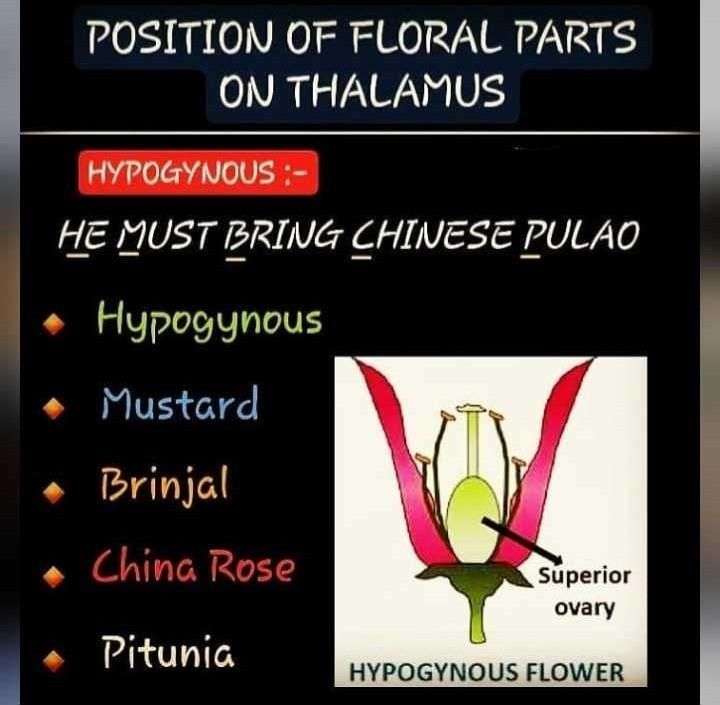NEET Exam > NEET Questions > Trick to remember example of hypogynous flowe...
Start Learning for Free
Trick to remember example of hypogynous flower__its all About to help you so don't answer please?
Most Upvoted Answer
Trick to remember example of hypogynous flower__its all About to help ...

Community Answer
Trick to remember example of hypogynous flower__its all About to help ...
Example of Hypogynous Flower
Hypogynous flowers are those in which the sepals, petals, and stamens are attached to the receptacle below the ovary. This type of flower is characteristic of the majority of flowering plants. An example of a hypogynous flower is the rose.
Rose as an Example
- The rose flower has sepals, petals, and stamens attached below the ovary on the receptacle.
- The sepals are the outermost whorl of the flower, followed by the petals, and then the stamens.
- The ovary is situated above these floral parts, making it a hypogynous flower.
Characteristics of Hypogynous Flowers
- In hypogynous flowers, the gynoecium is positioned superior to the other floral parts.
- The ovary is above the attachment of sepals, petals, and stamens.
- This floral arrangement is common in many flowering plants and is considered the most common type of flower morphology.
Importance of Understanding Flower Types
- Understanding different types of flowers, such as hypogynous, epigynous, and perigynous, is essential in botanical studies.
- It helps in the classification of plants and understanding their reproductive structures.
- Knowledge of flower types is crucial in fields like agriculture, horticulture, and botany for plant identification and breeding purposes.
In conclusion, the rose serves as an excellent example of a hypogynous flower, with its characteristic floral arrangement of sepals, petals, stamens, and ovary. Studying such examples helps in grasping the diversity and complexity of flowering plants.

|
Explore Courses for NEET exam
|

|
Similar NEET Doubts
Question Description
Trick to remember example of hypogynous flower__its all About to help you so don't answer please? for NEET 2025 is part of NEET preparation. The Question and answers have been prepared according to the NEET exam syllabus. Information about Trick to remember example of hypogynous flower__its all About to help you so don't answer please? covers all topics & solutions for NEET 2025 Exam. Find important definitions, questions, meanings, examples, exercises and tests below for Trick to remember example of hypogynous flower__its all About to help you so don't answer please?.
Trick to remember example of hypogynous flower__its all About to help you so don't answer please? for NEET 2025 is part of NEET preparation. The Question and answers have been prepared according to the NEET exam syllabus. Information about Trick to remember example of hypogynous flower__its all About to help you so don't answer please? covers all topics & solutions for NEET 2025 Exam. Find important definitions, questions, meanings, examples, exercises and tests below for Trick to remember example of hypogynous flower__its all About to help you so don't answer please?.
Solutions for Trick to remember example of hypogynous flower__its all About to help you so don't answer please? in English & in Hindi are available as part of our courses for NEET.
Download more important topics, notes, lectures and mock test series for NEET Exam by signing up for free.
Here you can find the meaning of Trick to remember example of hypogynous flower__its all About to help you so don't answer please? defined & explained in the simplest way possible. Besides giving the explanation of
Trick to remember example of hypogynous flower__its all About to help you so don't answer please?, a detailed solution for Trick to remember example of hypogynous flower__its all About to help you so don't answer please? has been provided alongside types of Trick to remember example of hypogynous flower__its all About to help you so don't answer please? theory, EduRev gives you an
ample number of questions to practice Trick to remember example of hypogynous flower__its all About to help you so don't answer please? tests, examples and also practice NEET tests.

|
Explore Courses for NEET exam
|

|
Signup to solve all Doubts
Signup to see your scores go up within 7 days! Learn & Practice with 1000+ FREE Notes, Videos & Tests.






















